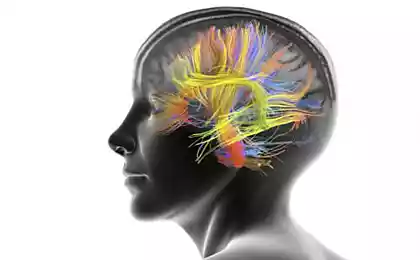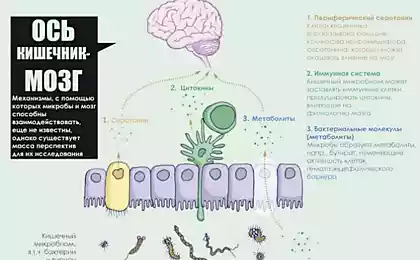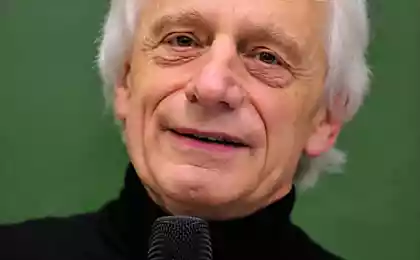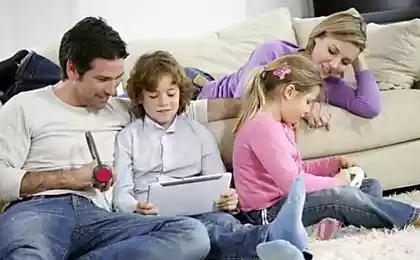659
Collective stupidity: what happens to the brain of a teenager
Psychology Professor Lawrence Steinberg believes that teenagers drink alcohol, smoke, or perhaps do not use condoms not from lack of knowledge, but because of the nature of brain development — risk appetite and other changes in behavior at this time are built into us genetically.
The Professor explains that this "peer effect", why would the schools program for the development of self-control, and why shouting at teenagers is pointless.
Fifty nine million nine hundred thirteen thousand nine hundred seventeen
"The social brain»
In addition to activation of the reward center of the brain beginning in puberty, it seems, stimulates changes in the brain regions responsible for human reaction to other people's opinion.
Region of the brain, which together are sometimes called the "social brain", aktiviziruyutsya when teenagers show photos showing other people's emotions; when they are asked to think about their friends; when asked to evaluate whether hurt other people's feelings, or when forced to feel social acceptance or rejection.
Any of us pay attention to the opinions of others, their thoughts and emotions. Simply adolescents it is manifested to a greater extent than adults. (Many experts involved in the study of autism, believe that the cause of this disease may be due to the irregularities in the "social brain.)
The transformation of the "social brain" continues in adolescence. That is why adolescents are particularly concerned about the opinion of them peers.
It is a neurobiological perfect storm (at least, if you want the person went through a painful process of self-awareness):
That's why changes in these brain areas lead to the fact that adolescent increased the importance of the question of their status in the peer group; they become more susceptible to pressure from their side, begin to discuss the others and "gossip" (and more to survive, if they themselves become the object of gossip).
Thirty two million three hundred ninety six thousand forty three
Specialists in the study of the brain found neurobiological reasons for this social drama.
To feel rejected is very unpleasant at any age, but in his youth it experienced a particularly painful. (The pain of social rejection are so similar to physical pain in their neurobiological characteristics, which is a little to reduce it helps paracetamol.)
Hypersensitivity to the opinions of others can have serious consequences: for example, according to many experts, cause a sharp increase in cases of depression in adolescence and to explain why depression is more prone to girls than boys.
From early childhood, girls are more receptive to everything that concerns interpersonal relationships. Psychological characteristics of girls can be an advantage when it comes to empathy, but they are more at risk of depression in a situation of social rejection.
Regardless of gender increased attention of teenagers to the emotions of others can reduce their ability to perceive potentially important information from the environment.
During a series of experiments, the scientists conducted brain scans of teenagers and adults in that time, as the demonstrated changing the sequence of the four types of images:
Participants were instructed to note when they see the red circles. In contrast to adults, brain activity in adolescents increased when they saw pictures with emotional people: it distracted them and disturbed to notice the appearance of red circles.
That is why the Creek is not the most effective way to convey to the teen a message: he pays more attention to the emotions of the speaker than the content of his speech.
I always suggest to parents who were angry with the behavior of their teenage children, to pause, to calm down, and yet say: "Now I'm too angry to talk to you about your act, but we will talk about this later, when I calm down". This strategy will increase the chances that future dialogue will be more productive.
Collective stupidity
In the business world has become axiomatic that groups of people make better decisions than individuals. This phenomenon is known as "collective intelligence". How this does not contradict our findings that adolescents do more stupid things in a group than alone?
Even among adults, the wise choice is not always the result of group decision-making. According to the research, the effect of group work is the most positive, when all members of the group openly share their own opinions. When group members are too concerned with how their words would perceive the other, there is a tendency to compromise, and the quality of decisions is worse than when the decision is made by individuals. Because of the increased concern of teenagers that think their peers, their reckless behavior when they are in the group, is understandable.
Twenty seven million ninety six thousand one hundred seventy eight
The decision-making process is subject to two competing systems of the brain:
Before the onset of adolescence skill of self-control is developed still poorly. However, around the middle of elementary school, this system of the brain gets enough development to keep under control supporting system.
If you imagine the brain in the form of scales with two bowls, in the preteen age, these bowls come in a state of equilibrium.
With the onset of puberty on the scales, which symbolizes supporting the system, there is an additional weight. With this additional force, which increases until approximately 16 years, on the scales with the system of self-regulation is not enough weight to maintain balance.
Fortunately, with the development of the prefrontal cortex additional weight gradually appears on the scales with the system of self-regulation, balancing the action of the reinforcing system. The desire for the reward is reduced, the skill of self-control increases, and the scales have come into balance.
However, this balance can easily be broken around mid-adolescence. Emotional arousal, fatigue and stress Deplete the self-regulation system, diverting energy from the control supporting system and disrupting the balance in favor of emotional incontinence.
Use in this age of soft drugs, for example, increases the desire of the brain to receive dopamine, and it stimulates an even more intense thrill and new experiences, whether it be more drugs, other illegal drugs or other activities that are only more fuels the desire of pleasure.
Instead of meet the need to reward one kind of rewarding incentives creates a desire for more.
In other words, the reward center of the brain, getting satisfaction from one source, begins to subconsciously look for the next source of pleasure. It's kind of like a drunk before a meal a glass of water to stimulate the appetite or as a Cup of coffee or a glass of wine often cause smokers desire to smoke a cigarette. Adolescents who are overweight, for example, there is increased susceptibility not only to images of food, but also to reward not related to food.
That is why hypermarkets are struggling to lead their visitors in a good mood: positive feelings derived from other sources, such as pleasant music or free snacks, and stimulate the desire for other rewards (i.e., shopping).
The owners of casinos offer players free drinks to their drunkard (if they had pursued that goal, not diluted the drink with water so much). They understand that a small stimulation of the reward center of brain using a single source of pleasure — diluted alcohol — it forces players to look for other sources of pleasure (the sound of slot machines). Therefore, more people eat and drink in good company than when they are not too comfortable. Feeling good, man tends to feel even better.
This explains the more reckless behavior of teenagers when they are in company. During adolescence interaction with peers activates the same reward centers that stimulate drugs, sex, food and money. From communicating with friends, adolescents have the same "shot of dopamine", as from other things, gives them pleasure. This is true for rodents in adolescence. To be around individuals of the same age are so pleased for them that this socialization stimulates chemical changes in the brain of adolescent animals, which resemble changes in the brain under the influence of alcohol! In adults this is not observed.
The mere presence of friends due to the increased sensitivity to social reward makes teenagers more sensitive to any other types of remuneration, including potential reward from a risky behavior. In the experiments for the study of risky behavior with simultaneous scanning of the brain we told the Teens that friends are watching them from another room, and one is immediately activated, they have centers of remuneration. In adults, this was not observed. And the more activated these centers, the more risk is willing to go the teenager. When adolescents were shown pictures with rewarding stimuli — a large pile of money, their reward center of intensified stronger if the teenager watched his friends than when the teen was alone. This "peer effect" was not observed when testing adults.
The influence of peers, making immediate rewards more attractive. We conducted several experiments in which participants were asked the question, what would they prefer: to obtain a small reward ($200), but now or large (a thousand dollars), but a year. The desire of adolescents to obtain immediate rewards increased in the presence of peers. Not even required the personal presence: it was enough to say that in the next room, the other party is watching them through the monitor.
In other words, to commit reckless acts in the company of friends-teenagers don't always make pressure from peers. Just when you're a teenager, being with friends is so great that the increased susceptibility to other types of remuneration, and it makes you do such things you yourself would never have ventured.
If to speak about concrete examples when the adolescents are in the company of friends, things like petty theft, experiments with drugs, unsafe driving or attempting to pay a visit to a friend at two in the morning, seem more attractive than when a teenager one.
The amplification effect of the reckless behavior of young people reaches its maximum, when teenagers know that there is a high probability that something bad happen.
Vulnerability to "peer effect" is still strong and around the age of 20 years. It would explain the infantile behavior of Mature College students, when they are in the company of friends.
One important implication of this research for parents: try to minimize the time that your teenage kids spend uncontrollably in the company of friends, as even quite affluent teenagers tend to act stupid when close friends.
"To be with individuals of the same age are so pleased for them that this socialization stimulates chemical changes in the brain which resemble changes under the influence of alcohol!»
So, we can conclude that due to the peculiarities of the development of the brain communicate with peers affect adolescents differently than adults. It is worth to adopt parents who should realize that adolescents exhibit more immature behavior when they are in a peer group than when I'm alone.
That is why the restrictions under which the driver is a teenager, until he has accumulated a certain experience, it is not allowed to carry as passengers other Teens, have proven to be very effective in reducing mortality due to car accidents; much more effective than merely training drivers.
For this reason, working parents, not having the opportunity to watch older children after school, you should not allow your children to invite friends or spending time at home in the company of other children, where parents were also not home.
The results of numerous studies suggests that in adolescence uncontrolled freedom of action in the company of peers — a sure way to trouble. Most Teens first try alcohol, drugs, sex and breaking the law is not at parties on Friday or Saturday, and on weekdays after school.
Parents are not the only people you need to take into account these findings. I once talked with a retired army General who was also a psychiatrist. I told him about our research on the influence of "peer effect" on the level of risk in decision-making and asked him how in the army, formed groups of soldiers for combat tasks. We rarely think about it, but a huge number of people who serve in the armed forces, especially in advanced, are young people: approximately 20% of active-duty service members (and more than a third of the Marines) are young people under the age of 21 and under. The Ministry of defence is the largest by a U.S. employer for people in this age group.
On combat missions soldiers mostly sent in groups of four. Each foursome must constantly make difficult decisions, often in a state of fatigue, stress, emotional arousal, that is, under the influence of those factors that reduce the quality of decision-making with the young people of this age. If the foursome consists exclusively of young people, especially under the age of 22, they take more risky decisions, than when the team mixed: young people and older people. My colleagues were allocated a grant to study whether a small mixed group consisting of both young and older people take better decisions than homogeneous small groups consisting only of young people. We hope that when our study is completed, we will be able to give recommendations on the optimal formation of the fighting groups, capable to make the most effective decisions with the least risk to themselves.
Our study of the behavior of young people in groups can also be useful for employers of this age group. I bet a few heads, forming working teams, think about the age of employees.
Employees of young age are better behaved and better make decisions when working in a group with people older than when the group consists entirely of people of the same age.
How to protect adolescents when they are unable to help themselves
[...] Research in the field of brain development of adolescents dramatically changed our understanding about this stage of life, however, many approaches to work with young people and the attitude towards them remains the same: outdated and even erroneous. As a result, we annually throw to the wind hundreds of millions of dollars on programs, the inefficiency of which can easily predict anyone who works with teenagers.
We have made significant progress in the prevention and treat common and chronic diseases in this age group, but can't boast the same success in reducing injury and mortality due to risky and reckless behavior among adolescents.
Although it is possible to observe a decrease in the level of certain risky behaviors (e.g., driving while intoxicated, or unprotected sex), the overall level of risk behaviour at this age is high and not declining over several years.
Since many forms of unhealthy behavior are laid in adolescence (for example, the habit of Smoking or drinking alcohol increases the risk of fixing this habit in adulthood, and dangerous driving or the Commission of crimes endangering the lives and health of others), reducing the risk behaviour of young people will significantly improve the situation in society as a whole.
For decades the primary means of achieving this goal was the educational program that is primarily conducted in schools. However, there is good reason to doubt the efficacy of these programs. Despite the nearly universal implementation of sex education lessons, 40% of high school students did not use condom last time had sex.
Although we require almost all teenagers listened to lectures about the dangers of drinking alcohol and Smoking, almost half of American teenagers have tried Smoking, and about 20% are regular smokers.
Approximately 40% of American high school students from time to time drank alcohol, and nearly 20% of monthly abuse alcohol.
Every year, almost 25% of teenagers travelling in the car when behind the wheel is a drunk driver. Almost 25% of the monthly smoke marijuana.
Given the almost ubiquitous availability of knowledge in the field of health and medicine, not to mention the attention to these issues in the press, it is hard to imagine that teenagers know nothing about the dangers of excessive weight. Almost one third of American high school students are overweight or obese.
We have had some success in reducing multiple risk behaviour, but in the last few years there have been no changes in such aspects as the use of contraceptives, obesity and Smoking; in fact, increased the number of suicides became more common Smoking marijuana.
Long-term monitoring of statistics on the use of different types of drugs do not leave illusions about the effectiveness of programs for conscious relationship to health and health education.
The use of alcohol and drugs is carefully monitored in the United States since 1975. Forty years ago, about a quarter of high school students smoked marijuana on a monthly basis. Almost the same happens today.
Twenty years ago, about one-third of high school students regularly drink alcohol. Almost the same thing today.
I think most people would be amazed to learn that today more eighth-grade students use drugs than 20 years ago. It is obvious that our efforts are not too efficient.
The only thing we have made significant and steady progress is the decline in Smoking among adolescents. However, most experts agree that it has almost no relation to the health education programmes. The number of Smoking adolescents today have decreased mainly due to the increase in cigarette prices almost twice inflation. In 1980 a pack of cigarettes cost an average 63 cents. Today its average price is 7 USD. Is it any wonder that teenagers today smoke less?
"Instead of trying to change teenagers, entering into an unequal battle with evolution and hormones, it is better to change the context in which manifested their natural desire for risky behavior»
The results of studies aimed at tracking changes in risk behavior over a period of time, can be interpreted in different ways, as there are many factors that can change over time and influence the trends in behavior. It may seem that ineffective program gives results if the time of its implementation will coincide with the moment when the behavior, to correct which this programme is aimed, suddenly begins to improve.
For example, a decrease in the level of cocaine use can be associated with the introduction of the educational program, and with the tightening of the relevant legislation. Conversely, a running program can seem ineffective if it is implemented at the moment is absolutely when for other reasons there is a growth of the phenomenon that the program was cut.
The program of prevention of offenses among teenagers far less likely to succeed in conditions of economic upheaval, when fewer teenagers unable to find work. But it is possible that this situation could have grown worse.
For this reason, it is important to get the results of controlled experiments, in which observe the behavior of randomly selected adolescents from the perspective of the impact of specific programs, and then compare the behavior of adolescents from the respective control groups. Such testing of "random sampling" is the gold standard by which you can really evaluate the effectiveness of different programs.
Unfortunately, the results of such assessments and the results of correlation studies has been disappointing. Conclusions systematic studies of the effectiveness of educational programs in the field of medical education indicate that even the best program is successfully affecting change in the level of knowledge young people do not change their behavior.
Indeed, more than a billion dollars spent annually in the United States on the implementation of programs, informing young people about the dangers of Smoking, alcohol consumption, unprotected sex and dangerous driving, but it does not render almost any influence on the behaviour of young people. Most taxpayers would be surprised and would feel righteous indignation if he knew that huge amounts are used to Finance educational programs that either do not work (for example, the program DARE189, program alcohol education, driving instruction), or their effectiveness remains unproven.
Taking into account what we know about the causes of the risky behavior of young people, it is safe to predict a low efficiency of educational programmes educating children about the dangers of certain risky actions. These programs affect what they know, but not how they behave. One information is not enough to prevent risky behaviour of young people, especially when they are on the stage of development when the excitation of the nervous system under the influence of the stimulus occurs rapidly, and the system of self-regulation still can not cope with the control of impulsive behavior.
The impression that the authors of these educational programs not only have no idea about the characteristics of adolescent development, but completely forgot their own younger years. Many of us teenagers found themselves in exactly the same situations and have made exactly the same mistakes. No educational program and the knowledge obtained would not stop us from unprotected sex, when we crossed a certain line, was not forced to refuse from cigarettes to marijuana, even if we promised ourselves that tonight, no, no, would not deter from the desire polihachit at the wheel from even a single beer when we have drunk.
Programs aimed at the development of teenagers overall ability to self-control have a much greater chance of success in the fight against risky behavior than those who are informed about the dangers of risky behavior. These programs focused on the development of generic skills of self-control in adolescents, and not just educate about the dangers of certain risky behaviors.
Society needs a new approach aimed at reducing risky behavior in adolescents. They need protection from themselves, particularly in the period when they are most vulnerable: when the self-regulation system currently under development, is not able to cope with high-strung supporting system. The desire to risk is a natural, genetically inherent and understandable from the point of view of the evolution of the characteristic behavior of young people. Perhaps it cannot be described as a necessity in modern conditions, but that's part of the genetic code, and change anything people are not able to. […]
Instead of trying to change teenagers, entering into an unequal battle with evolution and hormones, it is better to change the context in which manifested their natural desire for risky behavior.published
© Lawrence Steinberg
P. S. And remember, only by changing their consumption — together we change the world! ©
Source: //theoryandpractice.ru/posts/15921-effekt-sverstnikov-i-kollektivnaya-glupost-chto-proiskhodit-s-mozgom-podrostka
The Professor explains that this "peer effect", why would the schools program for the development of self-control, and why shouting at teenagers is pointless.
Fifty nine million nine hundred thirteen thousand nine hundred seventeen
"The social brain»
In addition to activation of the reward center of the brain beginning in puberty, it seems, stimulates changes in the brain regions responsible for human reaction to other people's opinion.
Region of the brain, which together are sometimes called the "social brain", aktiviziruyutsya when teenagers show photos showing other people's emotions; when they are asked to think about their friends; when asked to evaluate whether hurt other people's feelings, or when forced to feel social acceptance or rejection.
Any of us pay attention to the opinions of others, their thoughts and emotions. Simply adolescents it is manifested to a greater extent than adults. (Many experts involved in the study of autism, believe that the cause of this disease may be due to the irregularities in the "social brain.)
The transformation of the "social brain" continues in adolescence. That is why adolescents are particularly concerned about the opinion of them peers.
It is a neurobiological perfect storm (at least, if you want the person went through a painful process of self-awareness):
- improving the functioning of brain areas responsible for understanding what other people think;
- an increase in the excitability of brain areas that are sensitive to social acceptance or rejection;
- receptivity to the manifestation of the emotional state of other people, for example, the facial expression.
That's why changes in these brain areas lead to the fact that adolescent increased the importance of the question of their status in the peer group; they become more susceptible to pressure from their side, begin to discuss the others and "gossip" (and more to survive, if they themselves become the object of gossip).
Thirty two million three hundred ninety six thousand forty three
Specialists in the study of the brain found neurobiological reasons for this social drama.
To feel rejected is very unpleasant at any age, but in his youth it experienced a particularly painful. (The pain of social rejection are so similar to physical pain in their neurobiological characteristics, which is a little to reduce it helps paracetamol.)
Hypersensitivity to the opinions of others can have serious consequences: for example, according to many experts, cause a sharp increase in cases of depression in adolescence and to explain why depression is more prone to girls than boys.
From early childhood, girls are more receptive to everything that concerns interpersonal relationships. Psychological characteristics of girls can be an advantage when it comes to empathy, but they are more at risk of depression in a situation of social rejection.
Regardless of gender increased attention of teenagers to the emotions of others can reduce their ability to perceive potentially important information from the environment.
During a series of experiments, the scientists conducted brain scans of teenagers and adults in that time, as the demonstrated changing the sequence of the four types of images:
- red circle,
- abstract image,
- photos of people with neutral facial expression,
- people experiencing emotions.
Participants were instructed to note when they see the red circles. In contrast to adults, brain activity in adolescents increased when they saw pictures with emotional people: it distracted them and disturbed to notice the appearance of red circles.
That is why the Creek is not the most effective way to convey to the teen a message: he pays more attention to the emotions of the speaker than the content of his speech.
I always suggest to parents who were angry with the behavior of their teenage children, to pause, to calm down, and yet say: "Now I'm too angry to talk to you about your act, but we will talk about this later, when I calm down". This strategy will increase the chances that future dialogue will be more productive.
Collective stupidity
In the business world has become axiomatic that groups of people make better decisions than individuals. This phenomenon is known as "collective intelligence". How this does not contradict our findings that adolescents do more stupid things in a group than alone?
Even among adults, the wise choice is not always the result of group decision-making. According to the research, the effect of group work is the most positive, when all members of the group openly share their own opinions. When group members are too concerned with how their words would perceive the other, there is a tendency to compromise, and the quality of decisions is worse than when the decision is made by individuals. Because of the increased concern of teenagers that think their peers, their reckless behavior when they are in the group, is understandable.
Twenty seven million ninety six thousand one hundred seventy eight
The decision-making process is subject to two competing systems of the brain:
- supporting the system that seeks to obtain immediate stimulus,
- the system of self-regulation that keeps the impulses under control and forces us to think about the consequences.
Before the onset of adolescence skill of self-control is developed still poorly. However, around the middle of elementary school, this system of the brain gets enough development to keep under control supporting system.
If you imagine the brain in the form of scales with two bowls, in the preteen age, these bowls come in a state of equilibrium.
With the onset of puberty on the scales, which symbolizes supporting the system, there is an additional weight. With this additional force, which increases until approximately 16 years, on the scales with the system of self-regulation is not enough weight to maintain balance.
Fortunately, with the development of the prefrontal cortex additional weight gradually appears on the scales with the system of self-regulation, balancing the action of the reinforcing system. The desire for the reward is reduced, the skill of self-control increases, and the scales have come into balance.
However, this balance can easily be broken around mid-adolescence. Emotional arousal, fatigue and stress Deplete the self-regulation system, diverting energy from the control supporting system and disrupting the balance in favor of emotional incontinence.
Use in this age of soft drugs, for example, increases the desire of the brain to receive dopamine, and it stimulates an even more intense thrill and new experiences, whether it be more drugs, other illegal drugs or other activities that are only more fuels the desire of pleasure.
Instead of meet the need to reward one kind of rewarding incentives creates a desire for more.
In other words, the reward center of the brain, getting satisfaction from one source, begins to subconsciously look for the next source of pleasure. It's kind of like a drunk before a meal a glass of water to stimulate the appetite or as a Cup of coffee or a glass of wine often cause smokers desire to smoke a cigarette. Adolescents who are overweight, for example, there is increased susceptibility not only to images of food, but also to reward not related to food.
That is why hypermarkets are struggling to lead their visitors in a good mood: positive feelings derived from other sources, such as pleasant music or free snacks, and stimulate the desire for other rewards (i.e., shopping).
The owners of casinos offer players free drinks to their drunkard (if they had pursued that goal, not diluted the drink with water so much). They understand that a small stimulation of the reward center of brain using a single source of pleasure — diluted alcohol — it forces players to look for other sources of pleasure (the sound of slot machines). Therefore, more people eat and drink in good company than when they are not too comfortable. Feeling good, man tends to feel even better.
This explains the more reckless behavior of teenagers when they are in company. During adolescence interaction with peers activates the same reward centers that stimulate drugs, sex, food and money. From communicating with friends, adolescents have the same "shot of dopamine", as from other things, gives them pleasure. This is true for rodents in adolescence. To be around individuals of the same age are so pleased for them that this socialization stimulates chemical changes in the brain of adolescent animals, which resemble changes in the brain under the influence of alcohol! In adults this is not observed.
The mere presence of friends due to the increased sensitivity to social reward makes teenagers more sensitive to any other types of remuneration, including potential reward from a risky behavior. In the experiments for the study of risky behavior with simultaneous scanning of the brain we told the Teens that friends are watching them from another room, and one is immediately activated, they have centers of remuneration. In adults, this was not observed. And the more activated these centers, the more risk is willing to go the teenager. When adolescents were shown pictures with rewarding stimuli — a large pile of money, their reward center of intensified stronger if the teenager watched his friends than when the teen was alone. This "peer effect" was not observed when testing adults.
The influence of peers, making immediate rewards more attractive. We conducted several experiments in which participants were asked the question, what would they prefer: to obtain a small reward ($200), but now or large (a thousand dollars), but a year. The desire of adolescents to obtain immediate rewards increased in the presence of peers. Not even required the personal presence: it was enough to say that in the next room, the other party is watching them through the monitor.
In other words, to commit reckless acts in the company of friends-teenagers don't always make pressure from peers. Just when you're a teenager, being with friends is so great that the increased susceptibility to other types of remuneration, and it makes you do such things you yourself would never have ventured.
If to speak about concrete examples when the adolescents are in the company of friends, things like petty theft, experiments with drugs, unsafe driving or attempting to pay a visit to a friend at two in the morning, seem more attractive than when a teenager one.
The amplification effect of the reckless behavior of young people reaches its maximum, when teenagers know that there is a high probability that something bad happen.
Vulnerability to "peer effect" is still strong and around the age of 20 years. It would explain the infantile behavior of Mature College students, when they are in the company of friends.
One important implication of this research for parents: try to minimize the time that your teenage kids spend uncontrollably in the company of friends, as even quite affluent teenagers tend to act stupid when close friends.
"To be with individuals of the same age are so pleased for them that this socialization stimulates chemical changes in the brain which resemble changes under the influence of alcohol!»
So, we can conclude that due to the peculiarities of the development of the brain communicate with peers affect adolescents differently than adults. It is worth to adopt parents who should realize that adolescents exhibit more immature behavior when they are in a peer group than when I'm alone.
That is why the restrictions under which the driver is a teenager, until he has accumulated a certain experience, it is not allowed to carry as passengers other Teens, have proven to be very effective in reducing mortality due to car accidents; much more effective than merely training drivers.
For this reason, working parents, not having the opportunity to watch older children after school, you should not allow your children to invite friends or spending time at home in the company of other children, where parents were also not home.
The results of numerous studies suggests that in adolescence uncontrolled freedom of action in the company of peers — a sure way to trouble. Most Teens first try alcohol, drugs, sex and breaking the law is not at parties on Friday or Saturday, and on weekdays after school.
Parents are not the only people you need to take into account these findings. I once talked with a retired army General who was also a psychiatrist. I told him about our research on the influence of "peer effect" on the level of risk in decision-making and asked him how in the army, formed groups of soldiers for combat tasks. We rarely think about it, but a huge number of people who serve in the armed forces, especially in advanced, are young people: approximately 20% of active-duty service members (and more than a third of the Marines) are young people under the age of 21 and under. The Ministry of defence is the largest by a U.S. employer for people in this age group.
On combat missions soldiers mostly sent in groups of four. Each foursome must constantly make difficult decisions, often in a state of fatigue, stress, emotional arousal, that is, under the influence of those factors that reduce the quality of decision-making with the young people of this age. If the foursome consists exclusively of young people, especially under the age of 22, they take more risky decisions, than when the team mixed: young people and older people. My colleagues were allocated a grant to study whether a small mixed group consisting of both young and older people take better decisions than homogeneous small groups consisting only of young people. We hope that when our study is completed, we will be able to give recommendations on the optimal formation of the fighting groups, capable to make the most effective decisions with the least risk to themselves.
Our study of the behavior of young people in groups can also be useful for employers of this age group. I bet a few heads, forming working teams, think about the age of employees.
Employees of young age are better behaved and better make decisions when working in a group with people older than when the group consists entirely of people of the same age.
How to protect adolescents when they are unable to help themselves
[...] Research in the field of brain development of adolescents dramatically changed our understanding about this stage of life, however, many approaches to work with young people and the attitude towards them remains the same: outdated and even erroneous. As a result, we annually throw to the wind hundreds of millions of dollars on programs, the inefficiency of which can easily predict anyone who works with teenagers.
We have made significant progress in the prevention and treat common and chronic diseases in this age group, but can't boast the same success in reducing injury and mortality due to risky and reckless behavior among adolescents.
Although it is possible to observe a decrease in the level of certain risky behaviors (e.g., driving while intoxicated, or unprotected sex), the overall level of risk behaviour at this age is high and not declining over several years.
Since many forms of unhealthy behavior are laid in adolescence (for example, the habit of Smoking or drinking alcohol increases the risk of fixing this habit in adulthood, and dangerous driving or the Commission of crimes endangering the lives and health of others), reducing the risk behaviour of young people will significantly improve the situation in society as a whole.
For decades the primary means of achieving this goal was the educational program that is primarily conducted in schools. However, there is good reason to doubt the efficacy of these programs. Despite the nearly universal implementation of sex education lessons, 40% of high school students did not use condom last time had sex.
Although we require almost all teenagers listened to lectures about the dangers of drinking alcohol and Smoking, almost half of American teenagers have tried Smoking, and about 20% are regular smokers.
Approximately 40% of American high school students from time to time drank alcohol, and nearly 20% of monthly abuse alcohol.
Every year, almost 25% of teenagers travelling in the car when behind the wheel is a drunk driver. Almost 25% of the monthly smoke marijuana.
Given the almost ubiquitous availability of knowledge in the field of health and medicine, not to mention the attention to these issues in the press, it is hard to imagine that teenagers know nothing about the dangers of excessive weight. Almost one third of American high school students are overweight or obese.
We have had some success in reducing multiple risk behaviour, but in the last few years there have been no changes in such aspects as the use of contraceptives, obesity and Smoking; in fact, increased the number of suicides became more common Smoking marijuana.
Long-term monitoring of statistics on the use of different types of drugs do not leave illusions about the effectiveness of programs for conscious relationship to health and health education.
The use of alcohol and drugs is carefully monitored in the United States since 1975. Forty years ago, about a quarter of high school students smoked marijuana on a monthly basis. Almost the same happens today.
Twenty years ago, about one-third of high school students regularly drink alcohol. Almost the same thing today.
I think most people would be amazed to learn that today more eighth-grade students use drugs than 20 years ago. It is obvious that our efforts are not too efficient.
The only thing we have made significant and steady progress is the decline in Smoking among adolescents. However, most experts agree that it has almost no relation to the health education programmes. The number of Smoking adolescents today have decreased mainly due to the increase in cigarette prices almost twice inflation. In 1980 a pack of cigarettes cost an average 63 cents. Today its average price is 7 USD. Is it any wonder that teenagers today smoke less?
"Instead of trying to change teenagers, entering into an unequal battle with evolution and hormones, it is better to change the context in which manifested their natural desire for risky behavior»
The results of studies aimed at tracking changes in risk behavior over a period of time, can be interpreted in different ways, as there are many factors that can change over time and influence the trends in behavior. It may seem that ineffective program gives results if the time of its implementation will coincide with the moment when the behavior, to correct which this programme is aimed, suddenly begins to improve.
For example, a decrease in the level of cocaine use can be associated with the introduction of the educational program, and with the tightening of the relevant legislation. Conversely, a running program can seem ineffective if it is implemented at the moment is absolutely when for other reasons there is a growth of the phenomenon that the program was cut.
The program of prevention of offenses among teenagers far less likely to succeed in conditions of economic upheaval, when fewer teenagers unable to find work. But it is possible that this situation could have grown worse.
For this reason, it is important to get the results of controlled experiments, in which observe the behavior of randomly selected adolescents from the perspective of the impact of specific programs, and then compare the behavior of adolescents from the respective control groups. Such testing of "random sampling" is the gold standard by which you can really evaluate the effectiveness of different programs.
Unfortunately, the results of such assessments and the results of correlation studies has been disappointing. Conclusions systematic studies of the effectiveness of educational programs in the field of medical education indicate that even the best program is successfully affecting change in the level of knowledge young people do not change their behavior.
Indeed, more than a billion dollars spent annually in the United States on the implementation of programs, informing young people about the dangers of Smoking, alcohol consumption, unprotected sex and dangerous driving, but it does not render almost any influence on the behaviour of young people. Most taxpayers would be surprised and would feel righteous indignation if he knew that huge amounts are used to Finance educational programs that either do not work (for example, the program DARE189, program alcohol education, driving instruction), or their effectiveness remains unproven.
Taking into account what we know about the causes of the risky behavior of young people, it is safe to predict a low efficiency of educational programmes educating children about the dangers of certain risky actions. These programs affect what they know, but not how they behave. One information is not enough to prevent risky behaviour of young people, especially when they are on the stage of development when the excitation of the nervous system under the influence of the stimulus occurs rapidly, and the system of self-regulation still can not cope with the control of impulsive behavior.
The impression that the authors of these educational programs not only have no idea about the characteristics of adolescent development, but completely forgot their own younger years. Many of us teenagers found themselves in exactly the same situations and have made exactly the same mistakes. No educational program and the knowledge obtained would not stop us from unprotected sex, when we crossed a certain line, was not forced to refuse from cigarettes to marijuana, even if we promised ourselves that tonight, no, no, would not deter from the desire polihachit at the wheel from even a single beer when we have drunk.
Programs aimed at the development of teenagers overall ability to self-control have a much greater chance of success in the fight against risky behavior than those who are informed about the dangers of risky behavior. These programs focused on the development of generic skills of self-control in adolescents, and not just educate about the dangers of certain risky behaviors.
Society needs a new approach aimed at reducing risky behavior in adolescents. They need protection from themselves, particularly in the period when they are most vulnerable: when the self-regulation system currently under development, is not able to cope with high-strung supporting system. The desire to risk is a natural, genetically inherent and understandable from the point of view of the evolution of the characteristic behavior of young people. Perhaps it cannot be described as a necessity in modern conditions, but that's part of the genetic code, and change anything people are not able to. […]
Instead of trying to change teenagers, entering into an unequal battle with evolution and hormones, it is better to change the context in which manifested their natural desire for risky behavior.published
© Lawrence Steinberg
P. S. And remember, only by changing their consumption — together we change the world! ©
Source: //theoryandpractice.ru/posts/15921-effekt-sverstnikov-i-kollektivnaya-glupost-chto-proiskhodit-s-mozgom-podrostka























